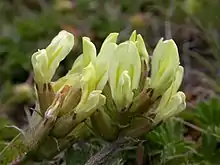| Oxytropis campestris | |
|---|---|
 | |
| Scientific classification | |
| Kingdom: | Plantae |
| Clade: | Tracheophytes |
| Clade: | Angiosperms |
| Clade: | Eudicots |
| Clade: | Rosids |
| Order: | Fabales |
| Family: | Fabaceae |
| Subfamily: | Faboideae |
| Genus: | Oxytropis |
| Species: | O. campestris |
| Binomial name | |
| Oxytropis campestris | |
| Synonyms | |
|
Oxytropis gracilis (A. Nelson) K. Schum. | |
Oxytropis campestris, the field locoweed,[1] is a plant native to Northern Europe, the mountains of Central & Southern Europe, the Northwestern United States and all of Canada, sometimes grown as an ornamental plant.
It is found in prairies, woods, and meadows, and prefers gravelly and rocky slopes, where it grows most abundantly. The plant has numerous variants. It is a larval host plant of the small blue butterfly[2]
Description
Oxytropis campestris blooms flowers from May to July. These are racemes that are capitate or oblong, 4 to 15 cm in length. The plants have 8 to 32 flowers that rise from a scape. The actual flowers have five lobes and form a calyx tube. They are of a cream to yellowish color, but sometimes of pink, blue, or purple, with hairs that are usually black. The keel petals are pointed, and often have purple blotches.
The plant also produces fruit which matures from July to September. These are legumes which are oblong-ovate 1.5 to 2 cm in length. They are mostly sessile and dehiscent from the tip. The fruit is membranous and contains many seeds.
The plant grows perennially, with an acaulescent forb reaching 20 to 50 cm in height and has a taproot.
Leaves grow alternately in a pinnate fashion and are usually 8 to 40 cm long. The leaves are dimorphic, with primary leaves short ovate leaflets, and secondary leaves with 11 to 33 leaflets. These secondary leaflets are 1 to 2.5 cm long.
Toxicity
The Oxytropis campestris plant is poisonous and may cause loco disease in livestock. From this it derives the common name field locoweed or some other variations. It is therefore worthless as food and is consumed only when other forage is not available.[3]
Conservation
Though this plant is common in general, one variety, var. chartacea, is a rare taxon limited to two counties in the state of Wisconsin. It is federally listed as a threatened species of the United States.[4][5]
See also
References
- ↑ USDA, NRCS (n.d.). "Oxytropis campestris". The PLANTS Database (plants.usda.gov). Greensboro, North Carolina: National Plant Data Team. Retrieved 26 July 2015.
- ↑ Asher, Jim. The millennium atlas of butterflies in Britain and Ireland. New York: Oxford University Press.
- ↑ Stubbendieck, James; Hatch, Stephan L; Butterfield, Charles H (February 1, 1992). North American Range Plants. U of Nebraska Press. ISBN 0-8032-9205-8. p. 357.
- ↑ USFWS. Determination of threatened status for Oxytropis campestris var. chartacea. Federal Register September 28, 1988.
- ↑ USFWS. Oxytropis campestris var. chartacea Five-year Review. 2009.
External links
 Media related to Oxytropis campestris at Wikimedia Commons
Media related to Oxytropis campestris at Wikimedia Commons- Pink, A. (2004). Gardening for the Million. Project Gutenberg Literary Archive Foundation.
